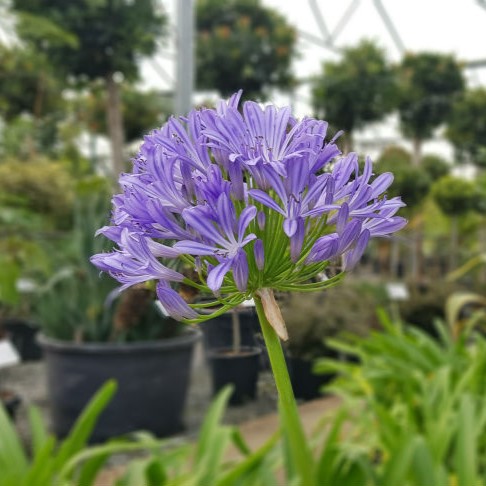Grasping the Art of Agapanthus Treatment: Necessary Steps for Healthy And Balanced Growth and Vibrant Flowers
In the realm of cultivation, the growing of agapanthus stands as a fulfilling venture for those that look for to nurture these elegant flowering plants. From choosing the best selection to grasping trimming methods, the journey towards growing prospering agapanthus plants is multifaceted and holds the vital to opening the full possibility of these botanical treasures.

Selecting the Right Agapanthus Range

When picking the ideal Agapanthus range for your garden, think about variables such as environment suitability, bloom color, and growth behavior. Agapanthus, typically called Lily of the Nile or African lily, comes in a selection of colors ranging from shades of blue and purple to white. Select a flower shade that complements your existing garden palette to produce an unified landscape. In addition, think about the climate in your area to guarantee the Agapanthus selection you select can flourish in your specific problems. Some ranges are much more forgiving of cold temperature levels, while others like warmer environments. Understanding the development practice of various Agapanthus selections is crucial for proper placement within your yard. Some ranges have a clumping growth habit, ideal for borders or containers, while others have an even more spreading nature, ideal for ground cover or mass growings. By very carefully assessing these factors, you can pick the ideal Agapanthus selection to enhance the charm of your garden.
Ideal Planting Conditions
Taking into consideration the ideal ecological requirements is vital for successful Agapanthus farming. Agapanthus prospers in well-draining soil with a slightly acidic to neutral pH level. When growing, pick a location that gets complete sunshine to partial color. In hotter climates, giving some mid-day shade can avoid scorching of the leaves. Agapanthus plants are delicate to cold temperatures and should be secured from frost throughout winter months.
To ensure healthy growth and lively blossoms, plant Agapanthus bulbs at a depth of regarding 2-4 inches and space them 8-12 inches apart. Mulching around the base of the plants helps preserve dampness and subdues weed development.
Watering and Fertilizing Tips
Preserving correct dampness degrees and offering crucial nutrients are crucial aspects in the treatment program for Agapanthus plants. When it comes to watering Agapanthus, it is crucial to strike an equilibrium. These plants favor continually damp dirt but are prone to root rot if overwatered.
Feeding Agapanthus is essential for promoting healthy growth and respected blooms. Apply a well balanced fertilizer, such as a 10-10-10 formula, in the very early springtime as new growth emerges. By complying with these watering and feeding pointers, you can ensure your Agapanthus plants flourish and generate dynamic, lasting flowers.
Trimming Strategies for Agapanthus
Pruning Agapanthus plants at the suitable times and with appropriate methods is vital for keeping their wellness and advertising optimum development check my source and blooming. The suitable time to prune Agapanthus is in late wintertime or early spring before brand-new development arises.
Deadheading spent blossoms can likewise reroute the plant's power right into creating more blossoms rather than establishing seeds. If you want to collect seeds for proliferation, leave some flowers to dry and mature on the plant.
Bear in mind to utilize clean, sharp tools to make accurate cuts and reduce the threat of introducing diseases. Agapanthus. Normal trimming will help maintain your Agapanthus looking neat and healthy while making certain a plentiful screen of stunning flowers
Dealing With Usual Bugs and Diseases
After making certain appropriate pruning strategies for Agapanthus, it is important to address usual insects and diseases that can affect the health and vigor of these plants. Agapanthus plants are generally sturdy yet can still succumb particular problems. One usual pest that influences Agapanthus is the Agapanthus gall midget. This little, orange fly lays its eggs in the vegetation, bring about altered development and flower buds that fail to open up. To battle this insect, trim and destroy any kind of affected plant components and consider utilizing insecticidal soap.
Furthermore, Agapanthus plants can experience from origin rot if they are grown in improperly draining pipes dirt. By being vigilant and taking prompt action versus pests and diseases, you can aid your Agapanthus plants grow and produce vibrant blossoms. Agapanthus.

Conclusion
To conclude, mastering the art of agapanthus care entails linked here selecting the right variety, providing suitable planting problems, correct watering and fertilizing, appropriate pruning strategies, and resolving typical pests and conditions. By following these important steps, you can make sure healthy development and vivid blossoms for your agapanthus plants. Keep in mind to consistently keep track of and preserve your plants to promote their total wellness and long life.
To guarantee healthy and balanced growth and lively blooms, plant Agapanthus bulbs at a deepness of regarding 2-4 additional reading inches and area them 8-12 inches apart. By following these watering and feeding ideas, you can guarantee your Agapanthus plants flourish and produce vivid, lasting blossoms.
One common parasite that affects Agapanthus is the Agapanthus gall midget. Additionally, Agapanthus plants can endure from root rot if they are grown in improperly draining soil. By adhering to these vital actions, you can guarantee healthy and balanced growth and lively blossoms for your agapanthus plants.